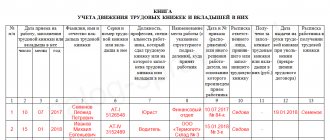The emergence of the need for accounting
The need to keep records of work records does not arise if the employee brings the form for storage at the personnel authority. After employment, a corresponding entry is made in the document with subsequent registration in the accounting journal. In this case, actions are limited to personnel records.
The need for accounting arises when an employee is employed without experience or there is no space in the book to enter text about hiring or dismissal. When maintaining records, a record of transactions accompanying the actions is made:
- Purchase of work books by the enterprise.
- Registration of documents.
- Issuance of the document to the employee.
- Acceptance of a fee equal to the cost of the enterprise's purchase.
A new document is issued after the employee applies to the manager with an application. According to Art. 65 of the Labor Code of the Russian Federation, an organization or individual entrepreneur is required to provide a new form or insert if it is missing or lost by the employee.
You must receive compensation for the provision of your work book. The refusal of the recipient of the document to pay the expenses of the organization or individual entrepreneur for the purchase of the form is not grounds for refusal to issue it. All actions related to the purchase, accounting, and write-off of documents are accompanied by accounting records.
How to write off a damaged form?
How to write off a damaged work book? In order to do this in accordance with all the rules established in the legislation, namely in the government decree on the storage and maintenance of work books, it is necessary to perform a number of step-by-step actions.
All of them require the participation of several personnel department employees , as well as the employer himself.
Each action must be carried out at a precise time, following the stated plan, only then the accuracy of the work you carry out will be at the highest level.
In order to write off a damaged form, the organization must issue an appropriate order that would allow the creation of commissions and the write-off.
Only after this can you begin to act.
First of all, you need to re -register your work records . Inspect all documents you have in your possession. There is no need to touch copies that have a presentable appearance; put them aside.
But outdated work books, frayed, stained or crossed out inside, should be sent for inspection.
The head of the personnel department must create a specialized commission from his subordinates. The legislator dictates the following name for us - inventory commission . This commission reviews the copies left for write-off and once again approves them for write-off.
Now you need to draw up a corresponding write-off act . We will talk about how to correctly compose this document in the next paragraph.
Later, a completely different commission is formed. The legislator calls it liquidation .
This commission consists of the same members as the previous one, but the fact of its creation is formalized by a separate order.
The commission attaches to the drafted act all employment forms that were not used for any reason.
Next, the documents are destroyed. This must be done in such a way that not a single work book survives and someone does not have two documents on work.
Basic norms in document flow
At enterprises, work books are recorded as strict reporting forms (SSR). Despite the prevalence of the document in retail, the only legal way to purchase is to purchase BSO forms from legal representatives of Goznak. The enterprise was organized on the basis of a federal institution and has been a joint-stock company since 2014. The company produces products marked with state marks, including work books.
In the document flow, responsible persons are guided by the Rules approved by GD dated March 16, 2003 No. 225 (hereinafter referred to as the Rules). To make entries, a journal is used - a receipt and expenditure book for recording forms and inserts.
Sample accounting book 2020
| ★ Best-selling book “Accounting from scratch” for dummies (understand how to do accounting in 72 hours) > 8,000 books purchased |
Results
Accounting for work records is a mandatory procedure for organizations. The choice of accounts for its management is a very controversial issue and is interpreted ambiguously by officials. We propose to use a scheme in which work books are accepted for accounting as BSO.
You can learn more about the features of accounting for work records in the articles:
- ;
- “How to properly certify a work book - sample”.
Sources:
- Labor Code of the Russian Federation
- Decree of the Government of the Russian Federation dated April 16, 2003 N 225
- tax code
- Resolution of the Ministry of Labor of Russia dated October 10, 2003 No. 69
- order of Rosarkhiv dated December 20, 2019 N 236
You can find more complete information on the topic in ConsultantPlus. Full and free access to the system for 2 days.
Procedure for maintaining the accounting book
Enterprise managers appoint persons responsible for maintaining the journal. The movement of documents is carried out in the company's accounting department.
When maintaining records, the procedure established by the Rules is applied: (click to expand)
- The magazine sheets are numbered and stitched with thread. The tabular part of the document after stapling must be accessible for writing and reading or photocopying.
- A seal is installed on the firmware indicating standard text about the number of sheets, the name of the enterprise and information about the certifying person. The entry must be certified by the signature of the director or a substitute person in accordance with the order.
- Records of the movement of forms or inserts are made in the book. Documents are issued to the personnel officer responsible for maintaining work records.
- Records are kept for each document indicating the series and number.
At the end of each monthly period, the responsible person must provide a report on the movement of books, the quantity at the beginning and end of the period, and whether they are registered. Additionally, indicate the amount of funds received to compensate for the costs of the enterprise.
Commercial companies and budgetary organizations are required to have a sufficient number of forms registered to meet the needs of employed persons (
Accounting entries when purchasing forms
Accounting for transactions for the purchase of work books is carried out using account 76 when purchasing by bank transfer. When registering, you must have an invoice issued by the seller. Work books purchased by an enterprise cannot be classified as goods. The reason is that the document is not intended for further resale.
Accounting for the movement of forms is mainly carried out by entries on account 10. A number of enterprises use account 41, which does not correspond to the position that there are no signs of the goods. When registering, an entry is simultaneously made to account 006, intended for accounting for BSO. Off-balance sheet accounting allows you to have information about the presence of the required number of documents on record.
| Purpose of the operation | Account debit | Account credit |
| Payment for forms has been made | 60 (76) | 51 |
| Posting of forms is reflected | 10 | 60 (76) |
| VAT from the supplier is included | 19 | 60 (76) |
| Forms accepted for off-balance sheet accounting | 006 |
In the future, when accounting for the movement of the form and funds to pay the cost, account 73 is used, to which subaccount 3 “Payments for work books” is opened.
How to receive forms
The employer acquired the forms as property. Meanwhile, the completed form, that is, the work book with entries about the employee included in it, is no longer the property of the employer. The work book is only kept by the employer, and upon termination of the employment contract it is issued to the employee (Article 84.1 of the Labor Code of the Russian Federation).
To what account should the form be sent?
Clause 47 of the “Rules for maintaining and storing work books, producing work book forms and providing them to employers”, approved by Decree of the Government of the Russian Federation dated April 16, 2003 No. 225, indicates that when issuing a work book to an employee, the employer charges him a fee, the amount of which is determined by the amount of expenses for their purchase. Please note: the fee is not charged when drawing up a work book, as most accountants are convinced, but precisely when handing it over, which is done upon termination of the employment contract. The date of issue of the work book upon dismissal is reflected in column 12 of the Book of Accounting for the movement of work books and inserts in them, the form of which was approved by Resolution of the Ministry of Labor of Russia dated October 10, 2003 No. 69. Until the book is issued to the employee, charging a fee for the form is obviously unlawful.
Now let's turn to paragraph 42 of the Rules, which determine the procedure for charging a fee for the form. It establishes: at the end of each month, the person responsible for maintaining work books is obliged to submit to the organization’s accounting department a report on the amounts received for issued work books and inserts in them, attaching a receipt order from the organization’s cash desk. But this order is subject to execution only in conjunction with the order of paragraph 47 of the Rules. Upon registration of the work book, no money will be charged for the form. This is not surprising: after all, the employee does not actually use the work book during the period of the employment contract. The employer “uses” it.
On a note
The employer is obliged to constantly have in stock the required number of work book forms (clause 44 of the Rules, approved by Decree of the Government of the Russian Federation of April 16, 2003 No. 225).
Meanwhile, the employer, not being the official distributor of the forms, has no right to sell them. Therefore, there can be no question of posting them to account 41 “Goods”. It is not prohibited to accept forms for accounting into account 10 “Materials”. After all, in the future they are used for the management needs of the organization. Then the accounts take the form:
DEBIT 10 CREDIT 60
- work book forms have been capitalized (excluding VAT);
DEBIT 73 CREDIT 10
- the cost of the form is written off when issuing a work book for an employee (based on the assumption that he will reimburse the cost of the form in the future).
Let us understand the nature of the asset that arises in account 73 “Settlements with personnel for other operations.” As stated above, it is payable no earlier than the date of dismissal. PBU 8/2010 (clause 13) classifies such a “debtor” as a contingent asset: it arises in an organization as a result of past events in its economic life, when the existence of an asset in the organization at the reporting date depends on the occurrence (non-occurrence) of one or more future uncertain events, not controlled by the organization. And the occurrence of such an event as dismissal really does not depend on the organization. Meanwhile, based on paragraph 14 of PBU 8/2010, contingent assets are not recognized in accounting. Information about them is disclosed in the financial statements. But with regard to forms, such a need does not arise - due to the insignificance of the cost of their stocks. This means that writing off forms does not create an asset, but an expense.
Now it will not seem surprising to us that the Ministry of Finance of Russia, in letter dated January 29, 2008 No. 07‑05‑06/18, proposes that the costs of purchasing work book forms should be immediately attributed to other expenses. Officials recommend taking into account data on the movement of forms in off-balance sheet account 006 “Strict reporting forms.” The accounting entries will look like this:
DEBIT 91 CREDIT 76
- reflects the costs of purchasing forms from distributors (excluding VAT);
DEBIT 006
- forms accepted for off-balance sheet accounting;
LOAN 006
- forms are used to prepare work books for employees.
The VAT presented by the distributor is deducted by the employer in the generally established manner.
Issuing a form to an employee without experience or an insert for it
In connection with the transfer of ownership from the employer to the employee, a VAT tax base arises. The tax billed by the supplier is deductible. The obligation to pay tax does not arise if the enterprise is not a VAT payer. The moment the VAT base arises is the day the work book is opened.
Example of issuing a form ⇓
The company Novost LLC hired employee V. without work experience. The acquisition cost after VAT was 100 rubles. The following entries were made in the accounting of Novost LLC:
- The cost of the completed form is included in the expenses: Dt 91/2 Kt 10 in the amount of 100 rubles;
- The accrual of VAT is reflected: Dt 91/2 Kt 68/1 in the amount of 18 rubles;
- The form was written off based on the certificate: Kt 006 in the amount of 100 rubles;
- The cost of the form is reflected in income: Dt 73/3 Kt 91/1 in the amount of 118 rubles;
- The amount of debt is withheld when calculating wages at the request of the person: Dt 70 Kt 73/3 in the amount of 118 rubles.
The moment of accounting for enterprise expenses is determined when costs arise - the purchase of forms. The amount of payment for the forms received is taken into account as part of income when a debt arises to the enterprise.
Free form
Issue employment record forms to employees free of charge if:
- an emergency occurred (fire, flood), as a result of which the employees’ work books were damaged;
- The work record form was spoiled by an employee of the organization responsible for personnel records during the initial filling.
This is stated in paragraphs 34 and 48 of the Rules approved by Decree of the Government of the Russian Federation dated April 16, 2003 No. 225, and the letter of the Ministry of Health and Social Development of Russia dated August 6, 2010 No. 12-3/10/2-6752 (in relation to work books that were lost in fires in July–August 2010).
Situation: is it possible not to charge an employee for a work book form?
Yes, you can.
But such a condition must be enshrined in a local regulatory act of the organization (for example, in the Labor Regulations or in the order of the manager).
In addition, this operation will have taxation specifics.
When calculating income tax (or a single tax when simplifying the difference between income and expenses), the cost of the form cannot be taken into account to reduce the tax base (clause 16 of article 270, clauses 1, 2 of article 346.16 of the Tax Code of the Russian Federation).
For the purpose of calculating VAT (if the organization pays this tax), the issuance of work books and inserts, including on a gratuitous basis, is recognized as a sale of goods. Therefore, you need to pay VAT on such a transaction (subclause 1, clause 1, article 146 of the Tax Code of the Russian Federation). The amount of VAT accrued on the cost of the form donated free of charge does not reduce the tax base for income tax (clause 16 of Article 270 of the Tax Code of the Russian Federation).
This procedure is confirmed by the Ministry of Finance of Russia in letters dated August 16, 2013 No. 03-03-05/33508, dated November 27, 2008 No. 03-07-11/367.
With regard to the deduction of personal income tax from the cost of a work book issued to an employee free of charge, the following must be taken into account.
If an organization issues a work book to an employee free of charge, then he has income in kind, from which personal income tax must be withheld (clause 1 of Article 210, subclause 1 of clause 2 of Article 211 of the Tax Code of the Russian Federation, letter of the Ministry of Finance of Russia dated November 27, 2008 No. 03-07-11/367). At the same time, the work book is transferred to the employee free of charge. This basis allows us to conclude that a gift agreement has been concluded between the employee and the organization. Such an agreement can be concluded either orally or in writing. This is stated in paragraph 1 of Article 572 and Article 574 of the Civil Code of the Russian Federation. In this case, providing an employee with a work book free of charge can be qualified as a gift. Income in the form of gifts is exempt from personal income tax in an amount not exceeding 4,000 rubles. for the year (clause 28 of article 217 of the Tax Code of the Russian Federation). Similar clarifications are contained in the letter of the Ministry of Finance of Russia dated June 1, 2010 No. 03-04-06/6-106.
Accounting for cash receipts
Enterprises must receive compensation for the cost of the document - the amount spent on its acquisition. The amount of the fee should not exceed the purchase price (excluding VAT). The possibility of receiving payment is provided for in clause 47 of the Rules. Despite the fact that the presentation of the work book is the responsibility of the company, the amount deposited by the employee into the cash register of the enterprise can be considered as revenue, the receipt of which requires the use of cash register equipment.
To avoid controversial issues with the tax office, the best option is to withhold the amount when calculating the employee’s wages. Withholding is carried out at the request of a person sent to the manager or chief accountant.
No deduction is made without the employee's consent: (click to expand)
| Purpose of the operation | Account debit | Account credit |
| Receipt of payment for the provided form at the cash desk is reflected | 50 | 73/3 |
| Deduction of the cost of the form from the payslip is reflected | 70 | 73/3 |
| Income from the fee received is reflected | 73/3 | 91/1 |
If an employee refuses to pay the amount spent by the employer on the purchase of a work book, the cost is written off from the company’s funds. The amount is reflected in other expenses of the enterprise.
Accounting for books provided free of charge
Free issuance of forms to employees occurs in the event of mass loss of books during storage at the enterprise or damage to the document due to the fault of the person in charge. In these cases, the company is obliged to provide forms to employed employees with no experience or in the absence of unfilled sheets free of charge. Legislative norms do not establish restrictions on the free issuance of work books and their inserts. When completing the procedure, the following features arise:
- To justify actions to issue forms free of charge, an order is issued.
- The procedure must be included in a local act, for example, a collective agreement.
- In calculating the base when calculating profits and the single tax, the costs of purchasing forms issued free of charge are not included. The cost of the issued book is subject to VAT; the seller's tax is not deductible.
Forms issued free of charge must be subject to personal income tax to the employee as income received. You can exclude taxation if you register 4,000 rubles as a non-taxable amount. If the form is issued in the form of a gift, the obligation to tax the amount does not arise (
Accounting of work books
Home / Work book
Business transactions for the acquisition and write-off of work book forms and inserts in them are subject to reflection in the organization’s accounting records.
The accounting procedure for these forms is currently not established by law. Over the years, the Ministry of Finance has repeatedly issued clarifications on this issue, which contradicted the current regulations, each other and more misled taxpayers than actually helped to keep records correctly.
As a result, today there are 2 options for recording work record forms:
- as assets sold to employees of the enterprise;
- as employer expenses.
The organization determines the method of accounting for forms independently and enshrines it in its accounting policies.
Work book is an asset of the organization
1) As a product for resale using account 41
The Ministry of Finance considers this accounting procedure in letter dated May 19, 2017 No. 03-03-06/1/30818.
It should be noted that most experts strongly disagree with this point of view of officials, because:
- the goods are property that is sold within the framework of contractual relations at the will of the parties, and the transfer of the work book occurs due to the requirements of the Labor Code of the Russian Federation and the employer cannot evade this obligation of his own free will;
- sales of forms are carried out exclusively by the GOZNAK Association or its authorized representatives; other persons have no right to sell forms;
- the employer charges the employee a fee for the form in the same amount that was previously paid to the official supplier, i.e., the costs incurred are actually reimbursed, and such an operation is not recognized as a sale.
2) How to materials using count 10
In this case, the forms are included as materials used for the management needs of the enterprise. This accounting procedure is considered more correct.
Since the costs of purchasing the forms are economically justified, they are recognized as expenses when calculating income tax (letter of the Federal Tax Service dated June 23, 2015 No. GD-4-3 / [email protected] ).
Funds received from employees in payment for forms are considered income of the organization (letter of the Federal Tax Service dated September 26, 2007 No. 07-05-06/242) and are also taken into account as part of the tax base for income tax.
Please note: companies using the simplified tax system will not be able to include the cost of purchased forms as expenses when calculating the single tax, since such costs are not included in the closed list given in paragraph 1 of Art. 346.16 Tax Code of the Russian Federation.
At the same time, it is recommended to include funds received for forms from employees as part of non-operating income in order to avoid claims from tax authorities.
The transfer of a work book form or an insert to it to an employee is subject to VAT (if the employer is a payer of this tax), and the amount of VAT previously presented by the seller of the forms is subject to deduction if there is correctly completed primary documentation.
Note:
Currently, there are decisions of the Supreme Arbitration Court with positive decisions in favor of taxpayers (FAS of the North-Western District dated 10/01/2003 No. A26-5317/02-28, 03/02/2007 No. A56-44214/2006), confirming the following position: issuing labor forms to employees . books, the employer does not aim to make a profit, but to fulfill the obligations imposed by legislative acts. Consequently, such transactions are not entrepreneurial activities and are not subject to VAT.
Purchased work forms and inserts for them, stored in the organization, are recorded in off-balance sheet account 006 as strict reporting forms.
Please note: you can write off the work book form (insert) on the day it is issued to the employee. In this case, the date of issue should not be considered the day of dismissal, but the day when the form was issued in the name of the employee.
Accounting entries:
| Dt | CT | Contents of operation |
| 10 (41) | 60 | Purchased forms are accounted for as inventories |
| 19 | 60 | VAT presented by the seller of the forms is reflected |
| 006 | The forms are accepted for storage as BSO | |
| 91 (90) | 10 (41) | The cost of completed forms is included in expenses |
| 91 (90) | 68 | VAT is charged on the cost of issued work book forms (inserts) |
| 006 | Work books (inserts) issued to employees were written off | |
| 73 | 91 (90) | The cost of the forms is reflected, subject to reimbursement by company employees |
| 70 (50) | 73 | The debt for the issued forms has been repaid from the employee’s salary (payment was paid by the employee to the company’s cash desk) |
If a local act of the organization establishes that compensation for labor forms. books and inserts for them are not charged to employees or emergency circumstances have occurred as a result of which the employer is obliged to issue the forms free of charge, write-off is carried out using the following entries:
| Dt | CT | Contents of operation |
| 91 | 10 (41) | The cost of forms issued free of charge has been written off |
| 91 | 68 | VAT is charged on the free transfer of the form to an employee |
| 006 | The work book form (insert) has been written off |
If the work book form (insert) was damaged by a company personnel employee during the filling out process, the following entries are made in accounting:
| Dt | CT | Contents of operation |
| 91 | 10 (41) | The cost of the damaged form has been written off |
| 19 | 68 | VAT, which was previously deductible, has been restored |
| 91 | 19 | Recovered VAT written off |
| 006 | The damaged form of the work book (insert) was written off |
In situations where a fee for the form is not charged to the employee, the enterprise does not have the right to take into account as income tax expenses either the cost of the forms or the VAT calculated on the gratuitous transfer of the form to the employee.
Thus, a difference arises between tax and accounting accounting, which is reflected as a permanent tax liability:
| Dt | CT | Contents of operation |
| 99 | 68 | A permanent tax liability for income tax is reflected |
In addition, if the form was transferred free of charge, then its value is recognized as the employee’s income in kind, and the employer, as a tax agent, is obliged to calculate and withhold personal income tax (letter of the Ministry of Finance dated November 27, 2008 No. 03‑07‑11/367).
Note: there is a different point of view on this issue, according to which a work book, as a personal document, cannot participate in civil circulation (this rule applies to a passport, education diploma, etc.). It turns out that when a form is issued in the name of an employee, the employer loses ownership rights, but the employee does not acquire it.
At the same time, since the employee cannot buy the form on his own, bypassing the employer, it is not possible to assess the economic benefit received, which could be recognized as a citizen’s income, in accordance with the Tax Code of the Russian Federation. Consequently, the object of personal income tax does not arise in this case.
There is a safer option: to qualify the gratuitous transfer of labor. books to an employee as a gift. The agreement can be concluded either in writing or orally. At the same time, income in the form of a gift worth up to 4,000 rubles. per year is not subject to personal income tax.
Work book is an expense of the organization
In this case, the opinions of the Ministry of Finance are reflected in the following official explanations:
- letter dated June 10, 2009 No. 03-01-15/6-305;
- letter dated January 29, 2008 No. 07-05-06/18 (recommendations to audit organizations),
according to which the employer does not purchase the forms for further sale, but acts as an intermediary between the employee and the seller of the forms. Thus, the employer does not have ownership of the forms.
At the same time, the provision of a work book (insert) to an employee cannot be qualified as the provision of a service.
Therefore, it is proposed to immediately take into account the cost of the forms as part of other expenses, and the compensation received for the forms from employees should be included in other income.
Consequently, the following entries will be made in the organization’s accounting records:
| Dt | CT | Contents of operation |
| 006 | The forms were accepted into the off-balance sheet account as BSO | |
| 91 | 60 | The cost of the forms is accepted as expenses |
| 19 | 60 | VAT reflected |
| 006 | Forms issued to employees written off | |
| 73 | 91 | The cost of the forms is reflected, subject to reimbursement by company employees |
| 91 | 68 | VAT is charged on the cost of issued forms |
| 70 (50) | 73 | The debt for the issued forms has been repaid from the employee’s salary (payment is made by the employee to the organization’s cash desk) |
Read in more detail: Accounting for work records (2 methods)
Did you like the article? Share on social media networks:
- Related Posts
- Application for issuance of a copy of the work book
- Extract from the work book
- Entry in the work book about the renaming of a position
- Receipt for receipt of work book
- Entries in the labor report about dismissal at the initiative of the employee
- How to calculate length of service using a work book
- Entry of award in work book: sample
- Application for sending a work book by mail








